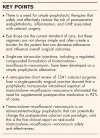Clinical outcomes after injection of a compounded pharmaceutical for prophylaxis after cataract surgery: a large-scale review
- PMID: 27653606
- PMCID: PMC5145248
- DOI: 10.1097/ICU.0000000000000329
Clinical outcomes after injection of a compounded pharmaceutical for prophylaxis after cataract surgery: a large-scale review
Abstract
Purpose of review: To evaluate relevant clinical outcomes following a transzonular intravitreal injection of a compounded triamcinolone-moxifloxacin-vancomycin (TMV) formulation for postoperative prophylaxis after cataract surgery in a retrospective review of medical records from a private practice, single-specialty ambulatory center in New Jersey, USA.
Recent findings: The analysis included 1541 cases from 922 patients who underwent cataract surgery with an intravitreal injection of TMV from November 2013 to December 2014. Cataract surgery was performed by a standard clear corneal phacoemulsification technique. Transzonular injection was used to deliver TMV directly into the anterior vitreous after implantation of an intraocular lens.
Summary: There were no major intraoperative complications associated with the transzonular injection technique. There were no cases of postoperative endophthalmitis. Nearly 92% of cases (n = 1413/1541) did not require supplemental medication after surgery. The rate of breakthrough inflammation at Days 14-21 was 9.2% (n = 132/1429). The rate of visually significant postoperative cystoid macular edema was 2.0% (n = 28/1429). The rate of clinically significant postoperative intraocular pressure increase was low: 0.9% (n = 13/1425) of cases had an at least 10 mmHg increase at Days 14-21 or 90. Four of these cases had intraocular pressure at least 30 mmHg. The rates of infection and inflammation reported in this retrospective review of a transzonular injection of TMV for prophylaxis after cataract surgery appear similar to reported rates with alternative prophylactic therapies such as topical drops. The transzonular injection of TMV may have advantages in terms of patient compliance.
Figures


References
-
- American Academy of Ophthalmology Cataract and Anterior Segment Panel Preferred practice Pattern® guidelines. Cataract in the adult eye. San Francisco, CA:American Academy of Ophthalmology; 2011.
-
- Lobo C. Pseudophakic cystoid macular edema. Ophthalmologica 2012; 227:61–67. - PubMed
-
- Sigler EJ, Randolph JC, Kiernan DF. Longitudinal analysis of the structural pattern of pseudophakic cystoid macular edema using multimodal imaging. Graefes Arch Clin Exp Ophthalmol 2016; 254:43–51. - PubMed
-
This article describes through spectral-domain OCT and fluorescein angiography the retinal structural changes that occur with pseudophakic cystoid macular edema (CME) and how these changes are reversed by treatment with periocular glucocorticoids.
-
- Miller JJ, Scott IU, Flynn HW, Jr, et al. Acute-onset endophthalmitis after cataract surgery (2000–2004): incidence, clinical settings, and visual acuity outcomes after treatment. Am J Ophthalmol 2005; 139:983–987. - PubMed
-
- Packer M, Chang DF, Dewey SH, et al. ASCRS Cataract Clinical Committee Prevention, diagnosis, and management of acute postoperative bacterial endophthalmitis. J Cataract Refract Surg 2011; 37:1699–1714. - PubMed
Publication types
MeSH terms
Substances
LinkOut - more resources
Full Text Sources
Other Literature Sources
Medical
Research Materials

